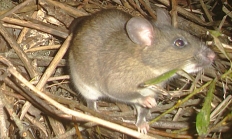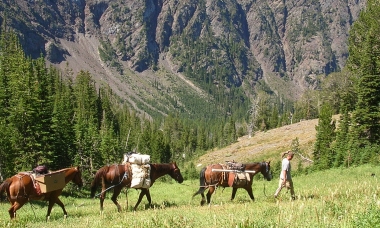
Search myodfw.com
With four wing-beats each second pushing them to 62 miles per hour, brant are the fastest and strongest geese in flight and among the swiftest of all large birds. Black brant comprise the vast majority of brant occurring in Oregon. These small geese have smoky black backs and bellies, and dissected white collars and white around the tails provide striking contrast. The black brant can live up to 20 years and are resilient enough to ride out storms on the open ocean. In Oregon, wintering numbers along the coast have seen a 50 percent reduction from previous years due to

The American badger is a medium-sized, powerfully built carnivore strongly adapted for digging. The body is flattened and the legs are short but stout; the toes of the forefeet are partly webbed and equipped with long, curved claws; the hind feet are shaped like miniature shovels; and each eye is equipped with a membrane that can be extended to cover it. The ears are rounded and densely covered with fur but seem large in comparison with those of many digging mammals. The tail is short and brushlike. Dorsally, the long, shaggy pelage is mottled grayish blending on the venter to


The dusky-footed woodrat is a medium-sized rat-like form with large, nearly naked ears, protruding eyes, and a long tail. The dorsal pelage consists of hairs with steel gray bases, a band of ocherous buff, and a tip of black. Hairs on the throat and belly are white. Although variably in extent, a dusky splotch occurs on the dorsal surface of the white feet. In Oregon, this woodrat occurs from the California border northward along the coast to near Bandon, northward inland through the Willamette Valley and other interior valleys to near Mollala and Monmouth, and northward to Brownsboro, Jackson County

Cascade Hatchery was authorized under the Mitchell Act and began operating in 1959 as part of the Columbia River Fisheries Development Program – a program to enhance declining fish runs in the Columbia River Basin. The facility is used for egg incubation and rearing of coho.

Cabela's - 7555 SW Nyberg St Tualatin, OR 97062

The goal of the Oregon Hatchery Research Center (OHRC) is to answer scientific questions related to fish recovery and hatchery programs. Information gained at the Research Center will help answer questions vital to the success of the Oregon Plan for Salmon and Watersheds and implementation of the Native Fish Conservation Policy. The Oregon Hatchery Research Center is a cooperative research project between the Oregon Department of Fish and Wildlife and the Oregon State University Department of Fisheries and Wildlife.
Turkey behavior changes over a hunting season. So it helps to think a bit like a turkey when planning your strategy for finding turkeys and setting up your hunt. Spring turkey behavior By the time hunting season opens on April 15, most of the hen turkeys have already bred. Though they may not be sitting on their nests quite yet. This keeps tom turkeys close to the hens during the first few weeks of the season, making it difficult for hunters to lure toms away from hens and into shooting range. If tom numbers are low, they are less likely


The ringtail is shaped somewhat like a marten with an elongated body and tail of approximately equal length. The ringtail is named for its tail which has has eight dark bands alternating with seven buffy bands. The dorsum is buff overlain with blackish or dark-brownish guard hairs; the venter is whitish or light buff. The face mask is whitish, but the eyes are fringed with a narrow band of black. The toes are equipped with semi-retractile claws, and except for the pads, furred on the ventral surface. The ears are long and set wide apart on a nearly horizontal plane

Summer Lake Wildlife Area was established in 1944, with primary objectives of protecting and improving waterfowl habitat and providing a public hunting area. It is now a popular destination for hunting, wildlife viewing and environmental education due to its geographic setting, the abundance of wildlife present and species diversity.
The common porcupine is a large, short-legged rodent with up to 30,000 bare-tipped quills (modified hairs) covering the upper parts of the body and the dorsal and lateral surfaces of the tail. The quills are scattered among much longer, course guard hairs; the underfur is woolly. The quills are arranged in rows across the body, the longest quills are on the rump, the shortest on the face. Quills used in defense are replaced commencing about 10-42 days after loss. The overall color of the porcupine is dark brown or blackish. The front feet have four toes, the rear feet five

ODFW's legislatively adopted 2025-27 budget did not include funding to continue the operation of Salmon River Hatchery. The hatchery is shifting fish production to other facilities but will remain open for public/fishing access with a volunteer host and occasional staff on site. Learn more.
Commission meets for online training Oct. 10
SALEM, Ore.–The Fish and Wildlife Commission will meet virtually on Friday, Oct. 10 from 8:30 a.m.-noon for a training related to cultural resources, tribal sovereignty, and tribal treaty rights. The meeting will be livestreamed from the Commission page and via ODFW's YouTube channel. Invited…

OHRC Board to meet virtually on Sept. 3
CORVALLIS, Ore . — The Oregon Hatchery Research Center Board will meet virtually via Zoom on Wednesday, Sept. 3 from 9:00 a.m. to 11:00 a.m. In addition to the regularly scheduled items, the agenda includes a review of a proposal for use of the remaining OHRC Research Fund. The meeting is open to…


Protecting and enhancing Oregon’s fish and wildlife, and the habitats they use, for the use and enjoyment of present and future generations is at the heart of what we do.

